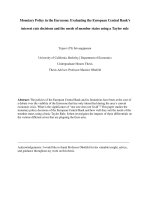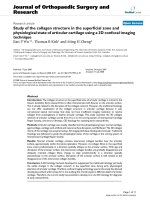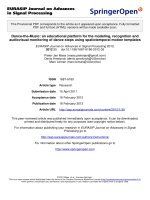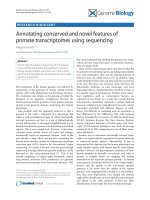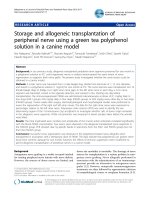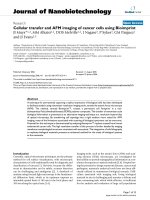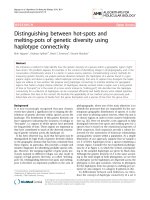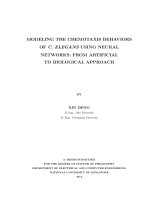Chiral and achiral separation of ten flavanones using supercritical fluid chromatography. Application to bee pollen analysis
Bạn đang xem bản rút gọn của tài liệu. Xem và tải ngay bản đầy đủ của tài liệu tại đây (1.82 MB, 12 trang )
Journal of Chromatography A 1685 (2022) 463633
Contents lists available at ScienceDirect
Journal of Chromatography A
journal homepage: www.elsevier.com/locate/chroma
Chiral and achiral separation of ten flavanones using supercritical fluid
chromatography. Application to bee pollen analysis
Ana M. Ares, José Bernal, Andrea Janvier, Laura Toribio∗
Department of Analytical Chemistry, Faculty of Sciences, I. U. CINQUIMA, Analytical Chemistry Group (TESEA), University of Valladolid, C/ Paseo de Belén 5,
Valladolid E-47011, Spain
a r t i c l e
i n f o
Article history:
Received 1 July 2022
Revised 28 October 2022
Accepted 30 October 2022
Available online 5 November 2022
Keywords:
SFC
Flavanones
Bee pollen
Enantiomeric separation
Stationary phases
a b s t r a c t
The separation of ten flavanones (flavanone, 2 -hydroxyflavanone, 4’-hydroxyflavanone, 6hydroxyflavanone, 7-hydroxyflavanone, naringenin, naringin, hesperetin, pinostrobin, and taxifolin)
using supercritical fluid chromatography and considering achiral and chiral approaches has been studied
in this work. For this purpose, different stationary phases and organic modifiers have been checked.
Considering the achiral separation, the best results were obtained with the Lichrospher 100 Diol column
at 35 °C, 3 mL/min, 150 bar and a gradient of 2-propanol from 5% to 50%. The baseline separation of the
ten compounds was achieved in 18 min. Using the chiral column Chiralpak AD, the separation of the ten
pairs of enantiomers was obtained in 32 min. In this case, the chromatographic conditions were 30 °C,
3 mL/min, 150 bar and the organic modifier was a mixture ethanol/methanol (80:20) containing 0.1%
of trifluoroacetic acid applied in an elution gradient from 15% to 50%. The applicability of the proposed
chiral method was assessed by analysing bee pollen samples and 2S-pinostrobin was determined in
some of them.
© 2022 The Author(s). Published by Elsevier B.V.
This is an open access article under the CC BY-NC-ND license
( />
1. Introduction
Flavanones are a sub-class of flavonoids produced by plants
as compounds of the secondary metabolism. They are widely distributed in nature and have caught the researchers’ interest due to
their health benefits and important properties; in particular, they
have been reported to have antioxidant, anticarcinogenic, cardioprotective or anti-inflammatory activities [1–5]. Flavanones have
one chiral centre at the C2 position and 3-hydroxyflavanones possess two chiral centres at the C2 and C3 positions. In nature, they
can exist both as free aglycones and as glycosidic conjugates, and
the 2S configuration is the predominant one [6].
One of the principal human sources of flavanones are fruits, especially those of the Citrus genus [1]. However, they have also been
found in other foods such as tomatoes [7,8], peanuts [9], or bee
products [10–13].
Traditionally the analysis of flavanones has been performed using liquid chromatography (LC) coupled to UV-visible diode-array
(DAD) or mass spectrometry (MS) detectors. The possibilities and
applications of these methods have been widely discussed in sev-
∗
Corresponding author.
E-mail address: (L. Toribio).
eral reviews [6,14,15]. Reverse phase mode on C18 columns with
binary mobile phases, composed of an acidic aqueous solution and
an organic solvent (methanol or acetonitrile), has been the choice
for achiral separations. On the other hand, flavanones are chiral
compounds and bioactive agents such as hormones, neurotransmitters etc. very often exhibit stereoselectivity, thus, one pair of enantiomers can show different pharmacokinetics or pharmacodynamics properties. Stereochemical differences have been proven to affect the bioavailability of flavonoids, as was shown for example for
catechin [16]. Moreover, differences in bioactivity or pharmacodynamics processes have been also found between the enantiomers
of hesperetin [17] and pinostrobin [18]. To further investigate the
mechanisms of action of the flavanones enantiomers and their distribution in natural products, enantiomeric methods of analysis are
necessary. It should be mentioned that chiral liquid chromatography had also been applied to perform this task, although the number of published works is much lower. In this case, polysaccharide
derivatives or cyclodextrins based columns were mostly employed
[19]. It should be noted that the number of enantiomeric pairs simultaneously resolved is usually small; in most cases, the enantiomeric separation of flavanones is studied individually [20–23].
Some papers have described the simultaneous enantiomeric determination of three [24] or six [25] flavanones. However, the baseline
/>0021-9673/© 2022 The Author(s). Published by Elsevier B.V. This is an open access article under the CC BY-NC-ND license
( />
A.M. Ares, J. Bernal, A. Janvier et al.
Journal of Chromatography A 1685 (2022) 463633
separation of all the enantiomers was not achieved and the determination was based on the use of MS detectors. Considering that
in natural products these compounds often occur in the presence
of each other, methods enabling the chiral separation of more than
one flavanone are of great interest.
Although the determination of flavanones has been successfully achieved using LC, especially for non-chiral separations, in
the last decade, the capabilities of supercritical fluid chromatography (SFC) for determining phenolic compounds in general and
flavanones in particular, has also been explored [26,27]. Due to the
singular properties of supercritical fluids, SFC offers several advantages over LC such as higher efficiencies and resolutions, shorter
analysis times and lower consumption of organic solvents, which is
one of the principles of the Green Analytical Chemistry [28]. Moreover, the introduction of a new generation of instruments, with improved robustness and performance, has contributed to renew the
interest in this technique. SFC has been widely used in chiral separations with successful results [29–31], but also the number of papers related to achiral separations have been increased in the last
years [32]. In this way, several papers have described the achiral
separation of flavanones from other phenolic compounds [33–35].
Polar stationary phases like silica, diol, or 2-ethylpyridyne were
predominantly selected, and elution gradients of organic modifiers
containing acidic additives were required for eluting the most polar compounds; even wide elution gradients that reached a 100% of
organic modifier have been used with great success [36]. Considering chiral separations, SFC has been scarcely employed in the chiral
analysis of flavanones and, as in LC, limited to one compound [37].
Therefore, the main goal of this work was to study, for
the first time, the separation of ten flavanones (flavanone,
2 -hydroxyflavanone, 4’-hydroxyflavanone, 6-hydroxyflavanone, 7hydroxyflavanone, naringenin, naringin, hesperetin, pinostrobin,
and taxifolin), which were present in nature and commercially
available, by using SFC. Taking into account that neither achiral nor
chiral separation of the ten compounds was previously described;
both approaches were studied. Moreover, the results obtained in
these studies would contribute to a better knowledge of the capabilities of SFC in the analysis of flavanones. In this regard, four
achiral and seven chiral stationary phases were assayed and the effect of different organic modifiers were evaluated with the aim of
achieving the best separation in the shortest time.
Moreover, a secondary goal of this work was to apply the proposed chiral method to the analysis of a complex real sample such
as bee pollen, which is rich in bioactive compounds, including
flavonoids [38].
2.2. Sample procurement and treatment
Bee pollen samples were obtained (n=3) from a local market (Valladolid, Spain) or were kindly donated (n=4) by the Centre for Agroenvironmetal and Apicultural Investigation (CIAPA;
Marchamalo, Guadalajara, Spain). They were ground and sieved
through 40 mesh, then they were dried overnight at 30 °C and
three subsamples were submitted to analysis. The extraction of flavanones was performed according to a previous published methodology [35]. Briefly, 5 g of sample was mixed with 25 mL of ethyl
acetate; then 12.5 mL of 40% ammonium sulphate and 2.50 mL
of 20% phosphoric acid were added. The flask was stirred for
20 min and centrifuged for 10 min (10 0 0 rpm). The remaining
solid residue was submitted to a second extraction process, and
the supernatants were combined and transferred to a separation
funnel. The organic phase was collected (top phase) and the aqueous phase was extracted again with 25 mL of ethyl acetate. All the
organic phases were collected in a flask and concentrated to dryness in a vacuum rotary evaporator at 30 °C. Finally, the residue
was dissolved in 2 mL of ethanol and filtered through 0.45 μm pore
size nylon filter. During all the process, the extracts were protected
from light using aluminium foil.
2.3. Instrumentation
The SFC system was manufactured by Jasco (Tokyo, Japan). It
was equipped with two pumps, PU-2080-CO2 and PU-2080, for
supplying the carbon dioxide and the modifier respectively. The
autosampler was an AS-2059-SF model and the injection volume
was set at 10 μL. The column was thermostated in a CO-2065
oven. The pressure was controlled by a BP-2080 pressure regulator and the detector employed was a MD-2015 photodiode-array
detector (PDA). Circular dichroism (CD) data were obtained using
another SFC Jasco system equipped with two PU-4180 pumps, an
AS-4350 autosampler, a CO-4065 oven a BP-4340 pressure regulator and a CD-4095 circular dichroism detector. System control and
data acquisition were performed by ChromNav 1.009.02 software
from Jasco.
The columns employed in this work are listed in Table 1.
A 5810 R refrigerated bench-top centrifuge from Eppendorf
(Hamburg, Germany), an R-3 rotary evaporator from Buchi (Flawil,
Switzerland), and Nylon syringe filters (17 mm, 0.45 μm; Nalgene,
Rochester, NY) were employed for sample treatment.
2.4. Method performance
Performance of the chiral chromatographic method was evaluated in terms of repeatability, intermediate precision, accuracy,
limit of detection (LOD), limit of quantification (LOQ) and linearity.
Instrumental repeatability was evaluated by injecting a
10.0 μg/mL standard solution six times during the same day.
Intermediate precision was determined at three different levels: 2.5, 10.0 and 50.0 μg/mL and each standard was injected
three times during three consecutive days. In all cases the relative standard deviation of retention times and peak areas were
calculated.
Accuracy was determined at three concentration levels (2.5,
10.0 and 50.0 μg/mL), by injecting three replicates of each solution and the ratio of the calculated concentration to the nominal
concentration was evaluated. LOD and LOQ were calculated as 3
and 10 times the signal to noise ratio (S/N) respectively.
Finally, linearity was assessed using calibration standards prepared at six concentration levels (LOQ, 5.0, 10.0, 25.0, 50.0 and
100.0 μg/mL). Each calibration level was prepared by triplicate and
from different stock solutions.
2. Material and methods
2.1. Reagents and standards
All the organic solvents employed (methanol, ethanol, isopropanol, ethyl acetate) were HPLC grade and obtained from
LAB-SCAN (Dublin, Ireland). Racemic solid standards of flavanone
(FLV), 2 -hydroxyflavanone (2’-OHFLV), 4’-hydroxyflavanone (4’OHFLV), 6-hydroxyflavanone (6-OHFLV), 7-hydroxyflavanone (7OHFLV), naringenin (NGEN), naringin (NGIN), hesperetin (HESP),
pinostrobin (PINO), and taxifolin (TAXI) were purchased from
Sigma-Aldrich (Madrid, Spain). Their standard stock solutions were
prepared in methanol at the 500 μg/mL level and were stored at
4 °C. The working solutions were prepared by appropriate dilution
of the stock solutions with methanol. Trifluoroacetic acid (TFA),
acetic acid, ammonium sulphate and phosphoric acid were of analytical grade and obtained from Sigma-Aldrich (Madrid, Spain). Carbon dioxide was SFC grade and obtained from Carburos Metálicos
(Barcelona, Spain).
2
A.M. Ares, J. Bernal, A. Janvier et al.
Journal of Chromatography A 1685 (2022) 463633
Table 1
Columns employed in the work.
Achiral columns
Chiral
columns
Column
Stationary phase
Dimensions
Hypersil silica
Lichrospher CN
Lichrospher 100 diol
DCpak PBT
Bare silica
Cyanopropyl bonded to silica gel
Propanediol bonded to silica gel
polybutylene terephthalate (PBT)
coated on silica gel
Amylose-tris(3,5dimethylphenylcarbamate) coated
on silica gel
Cellulose
tris(3,5-dimethylphenylcarbamate)
coated on silica gel
Amylose tris(3-chloro-5methylphenylcarbamate)
inmobilized on silica gel
Cellulose tris(3-chloro-4methylphenylcarbamate) coated
on silica gel
Amylose tris(5-chloro-2methylphenylcarbamate) coated
on silica gel
1-(3,5-Dinitrobenzamido)1,2,3,4,-tetrahydrophenanthrene
bonded to silica gel
Cellulose
tris(3,5-dichlorophenylcarbamate)
inmobilized on silica gel
250
250
250
250
Chiralpak AD
Chiralcel OD
Lux i-Amylose-3
Lux Cellulose-2
Lux Amylose-2
Regis S,S-Whelk-O1
Regis Reflect I-Cellulose C
×
×
×
×
4.6
4.6
4.6
4.6
mm,
mm,
mm,
mm,
Phenomenex (Madrid, Spain)
Phenomenex (Madrid, Spain)
Merck (Madrid, Spain)
Chiral Technology Europe (Illkirch, France)
250 × 4.6 mm, 10μm
Chiral Technology Europe (Illkirch, France)
250 × 4.6 mm, 10μm
Chiral Technology Europe (Illkirch, France)
250 × 4.6 mm 3 μm
Phenomenex (Madrid, Spain)
250 × 4.6 mm, 5 μm
Phenomenex (Madrid, Spain)
250 × 4.6 mm, 5 μm
Phenomenex (Madrid, Spain)
150 × 4.6 mm, 3.5μm
Regis Technology (Chicago USA)
150 × 4.6 mm, 3 μm
Regis Technology (Chicago USA)
Fig. 1. Names and structures of the compounds studied.
3
Supplier
5 μm
5 μm
5 μm
5μm
A.M. Ares, J. Bernal, A. Janvier et al.
Journal of Chromatography A 1685 (2022) 463633
Fig. 2. Chromatograms obtained with the Hypersil silica and Lichrospher CN columns. The Chromatographic conditions were 35 °C, 150 bar, 3mL/min, gradient of methanol:
from 0.0 to 5.0 min it was held at 3%, from 5.0 to 10.0 min it was increased to 20 %, from 10.0 to 15.0 min it was increased to 50% which was held for 5 min. Detection at
220 nm.
3. Results and discussion
On the Lichrospher 100 diol column the retention was
lower than using the DCpak PBT one. This could be probably because on the last column the π -π interactions are
favoured causing an increase on the retention. Generally, on
both columns, the retention increased as the number of hydroxyl groups incremented, but the elution order in each column was different (see Table 2). Pinostrobin showed a much
higher retention on the DCpak PBT column and the elution
order of the pairs 6-hydroxyflavanone/2’-Hydroxyflavanone, 7hydroxyflavanone/4’-hydroxyflavanone and hesperetin/naringenin
was reversed with respect to that observed on the Lichrospher 100 diol. Different organic modifiers and gradients were
checked to improve the resolution between 6-hydroxyflavanone,
2’-hydroxyflavanone, 4’-hydroxyflavanone, 7-hydroxyflavanone and
pinostrobin. In the case of the Lichrospher 100 diol column, the
best results were obtained when working at 35 °C, 3mL/min, 150
bar and using 2-propanol as modifier delivered according with the
following gradient: from 0.0 to 2.0 min it was held at 5%, from 2.0
to 3.0 min it was increased to 15%, from 3.0 to 8.0 min it was increased to 20%, from 8.0 to 13.0 min it was increased to 50% which
was held for 7 min. Under these conditions the compounds were
separated in 18 min with resolutions higher than 1.5 (see Fig. 3a).
Meanwhile, the separation of the compounds on the DCpak PBT
column was achieved at 40 °C and using a gradient of methanol
3.1. Achiral separation
The separation of the flavanones was studied using four
different types of stationary phases: silica, cyano, diol, and
poly(butylene terephthalate). The selection of the stationary phases
was based on the published papers related to the achiral SFC separation of polyphenols, including flavanones [35,39–41]. The use
of an organic modifier was necessary to obtain reasonable retention times, as the analytes have several functional groups (see
Fig. 1) that can interact with the stationary phases through hydrogen bonding and/or π -π interaction. Three organic modifiers were
checked in this work: methanol, ethanol and 2-propanol. In all the
cases, the compounds with the higher number of hydroxyl groups
(naringenin, hesperetin, taxifolin and naringin) showed the highest
retention and their elution was achieved increasing the percentage of organic modifier, thus working in gradient elution mode was
mandatory. Retention increased in the order methanol
results. The peaks obtained were broad and several compounds
coeluted (see Fig. 2). The best results were obtained with the diol
and poly(butylene terephthalate) based columns.
4
A.M. Ares, J. Bernal, A. Janvier et al.
Journal of Chromatography A 1685 (2022) 463633
Table 2
Comparison between retention on Lichrosphere 100 diol and DCpak PBT columns. Chromatographic
conditions: 35 °C, 150 bar, 3 mL/min. Gradient of methanol: 0.0 min–5.0 min (10%), 15.0–25.0 min
(30%).
Lichrosphere 100 diol
Compound
tr (min)
DCpak PBT
Compound
tr (min)
Flavanone (FLV)
Pinostrobin (PINO)
6-hydroxyflavanone (6-OHFLV)
2’- hydroxyflavanone (2’-OHFLV)
4’ –hydroxyflavanone (4’-OHFLV)
7- hydroxyflavanone (7-OHFLV)
Hesperetin (HESP)
Naringenin (NGEN)
Taxifolin (TAXI)
Naringin (NGIN)
1.32
1.45
2.78
2.82
2.95
3.31
8.75
9.23
10.51
11.73
Flavanone (FLV)
2’- hydroxyflavanone (2’-OHFLV)
6-hydroxyflavanone (6-OHFLV)
7- hydroxyflavanone (7-OHFLV)
4’ –hydroxyflavanone (4’-OHFLV)
Pinostrobin (PINO)
Naringenin (NGEN)
Hesperetin (HESP)
Taxifolin (TAXI)
Naringin (NGIN)
2.68
3.77
3.95
4.09
4.40
4.25
10.09
10.45
11.12
12.48
Fig. 3. Chromatogram obtained with the achiral columns. A- Lichrospher 100 diol column. Chromatographic conditions: 35 °C, 3mL/min, 150 bar. Gradient of 2-propanol:
from 0.0 to 2.0 min it was held at 5%, from 2.0 to 3.0 min it was increased to 15%, from 3.0 to 8.0 min it was increased to 20%, from 8.0 to 13.0 min it was increased to
50% which was held for 7 min. B- DCpak PBT column. Chromatographic conditions: 40 °C, 3 mL/min, 150 bar. Gradient of methanol: it started at 5%, at 7.0 min it increased
to 10%, from 7.0 to 11.0 min it was increased to 20%, which was held for 9.0 min. Detection at 220 nm.
5
A.M. Ares, J. Bernal, A. Janvier et al.
Journal of Chromatography A 1685 (2022) 463633
Fig. 4. Effect of the organic modifier on enantioresolution and retention time of the second eluted enantiomer, using the Chiralpak AD and Lux Amylose-3 columns. Chromatographic conditions: 35 °C, 2mL/min and 150 bar. Gradient of methanol: from 0.0 to 2.0 min it was held at 20%, from 2.0 to 20.0 min it was increased to 40%, which
was held for 30.0 min. Detection at 220 nm.
(it started at 5%, at 7.0 min it increased to 10%, from 7.0 to 11.0 min
it was increased to 20%, which was held for 9.0 min). As it can
be seen in Fig. 3b, the analysis time was similar to that obtained on the Lichrospher 100 diol column; but the column efficiency was lower especially for 2’-hydroxyflavanone, taxifolin and
naringin.
2-propanol has a lower polarity than the other two modifiers,
thus the opposite retention behaviour could have been expected.
Nevertheless, this behaviour has also been observed for other
compounds using amylose based columns [35,42]. It could be
explained in terms of the hydrogen bond accepting ability. The
studied compounds have several functional groups with hydrogen
bond accepting ability and their retention is lower when the
hydrogen bond-accepting ability of the modifier increases; on the
contrary, the enantioresolution increases when the hydrogen bond
accepting ability of the modifier decreases. The hydrogen bond
accepting ability of the modifiers assayed increases in the order
methanol
some cases caused the loss of the enantioresolution. Therefore,
it can be concluded that the highest enantioresolutions were
achieved with methanol and ethanol.
The best results, using the Lux Amylose-3 column, were obtained using methanol as organic modifier and the following gradient: from 0.0 to 2.0 min, it was held at 25%, from 2.0 to 15.0 min
it was increased to 40%, which was held for 25 min. As it can be
observed in Fig. 5, using this column, the enantiomers from different compounds coeluted, and the simultaneous chiral separation of
the ten pairs of enantiomers was not possible. Further changes in
temperature and pressure did not improve the separation. In relation to the Chiralpak AD column, the best performance was obtained at 30 °C, 3mL/min, 150 bar and using as modifier a mixture
ethanol/methanol (80:20; v/v) delivered according to the following gradient: from 0.0 to 10.0 min it was held at 15%, from 10.0
to 23.0 min it was increased to 28%, and from 23.0 to 40.0 min it
was increased to 50%. Under these conditions, good results were
obtained for the simultaneous chiral separation of the ten pairs of
enantiomers, and except for naringin, all the enantiomers were resolved. Taxifolin presented severely tailed peaks (Fig. 6a), but this
issue was circumvented by using 0.1% of trifluoroacetic acid (TFA)
as additive (Fig. 6b), moreover the separation between 2’- hydrox-
3.2. Chiral separation
3.2.1. Column selection and mobile phase optimization
The enantiomeric separation of the flavanones was studied using seven different chiral columns. The chiral selectors employed
included Pirkle-type as well as cellulose and amylose carbamate
derivatives (Table 1). Based on the previous experiments (data not
shown), the initial conditions were 35 °C, 2mL/min and 150 bar.
The use of a gradient of organic modifier was necessary in order
to decrease the retention time of the compounds with a high number of hydroxyl groups. Initially, methanol was the organic modifier
selected and it was delivered according to the following gradient:
from 0.0 to 2.0 min, it was held at 20%, from 2.0 to 20.0 min it
was increased to 40%, which was held for 30.0 min. The results
obtained are presented in Table 3. As can be seen, the best chiral
separations were obtained with the amylose derived columns, especially with Chiralpak AD and Lux Amylose-3, which provided the
highest enantioresolutions for all the compounds studied. In general, the retention was also higher on the amylose columns, obtaining the longest retention times on the Chiralpak AD column.
Taking into account these results, Chiralpak AD and Lux Amylose-3
were the columns selected to continue the work.
In order to achieve the simultaneous resolution of the ten
pairs of enantiomers, different organic modifiers (methanol,
ethanol and 2-propanol) and gradients were checked on both
columns. Considering the effect of the type of organic modifier, in all cases, retention and resolution increased in the order
2-propanol
6
Rs
0
0.2
0
3.0
1.2
0
0
1.1
1.5
1.1
t1
3.0
3.8
4.0
3.4
4.7
5.3
8.5
9.5
9.3
9.5
t2
3.0
3.9
4.0
3.8
4.9
5.3
8.5
9.7
10.0
9.7
Regis S,S- Welk-O1
Columns
– Not eluted in 50 min.
FLV
PINO
6-OHFLV
2’-OHFLV
4’-OHFLV
7-OHFLV
HESP
NGEN
TAXI
NGIN
Compounds
Rs
1.9
1.5
0.9
0
0
1.3
1.3
0.5
1.3
2.0
t1
3.2
4.5
8.1
7.0
9.5
14.9
14.9
12.0
16.6
24.8
t2
3.4
4.7
8.2
7.0
9.5
15.2
15.2
12.1
17.6
26.1
Regis Reflect I- Cellulose C
Rs
3.0
5.0
2.2
3.7
0
0
0
1.1
0
—–
t1
3.9
5.0
5.2
4.3
5.6
11.2
11.2
8.7
16.8
Chiralcel OD
t2
4.4
6.1
5.6
4.9
5.6
11.2
11.2
9.2
16.8
Rs
0.9
1.0
1.1
1.5
1.8
2.9
2.9
2.7
0
1.5
t1
3.7
5.7
6.4
4.6
7.6
12.1
12.1
8.6
24.2
32.0
Lux Cellulose-2
t2
3.8
5.9
6.6
4.9
8.1
13.9
13.9
9.9
24.2.
34.9
Rs
15.7
3.8
17.9
23.8
13.9
9.8
10.3
5.1
8.1
0.3
t1
6.8
19.4
20.6
6.2
11.7
11.7
30.3
18.3
18.6
17.2
Chiralpak AD
t2
13.9
22.8
45.3
17.2
20.2
17.2
47.6
21.8
31.6
17.3
Rs
7.9
4.1
11.9
12.2
5.5
0
0
1.3
—
0
t2
9.1
11.5
17.9
15.1
14.6
19.6
19.6
15.6
26.1
t1
6.8
9.3
12.4
10.9
12.9
19.6
19.6
15.2
26.1
Lux Amylose-2
Rs
18.6
17.2
16.4
24.7
16.3
16.9
16.9
4.6
17.4
1.3
t1
4.9
11.7
14.6
3.7
9.7
20.5
20.5
12.6
11.1
12.9
Lux Amylose-3
t2
9.1
21.1
25.2
9.2
15.4
37.0
37.0
14.7
25.2
14.3
Table 3
Resolutions and retention times (minutes) obtained with the chiral columns studied and for the individual injection of each flavanone . Chromatographic conditions: 35 °C, 2 mL/min, 150 bar and methanol as organic modifier
delivered according with the following gradient: 0.0–2.0 min (20%), 20.0–50.0 min (40%).
A.M. Ares, J. Bernal, A. Janvier et al.
Journal of Chromatography A 1685 (2022) 463633
Fig. 5. Chiral separation using the Lux Amylose-3 column. Chromatographic conditions: 35 °C, 2mL/min and 150 bar. Gradient of methanol: from 0.0 to 2.0 min it
was held at 25%, from 2.0 to 15.0 min it was increased to 40%, which was held for
25 min. Detection at 220 nm. A) mixture 1: 2’-OHFLV, 7-OHFLV, 6-OHFLV and HESP.
B) mixture 2: FLV, 4’-OHFLV, PINO and NGEN. C) mixture 3: TAXI and NGIN.
yflavanone(1)/flavanone(2) and 4’–hydroxyflavanone(1)/7- hydroxyflavanone(2) improved.
Therefore, it can be concluded that the best overall performance
was obtained with the Chiralpak AD column under the abovementioned conditions.
3.2.2. Enantiomers elution order
The elution order of the enantiomers was determined using the
Chiralpak AD column and a CD detector coupled to the SFC system. As can be seen in Table 4, in all the cases, except for naringenin, the first eluted enantiomer presented a positive CD signal, while the opposite behaviour was observed for the second
7
A.M. Ares, J. Bernal, A. Janvier et al.
Journal of Chromatography A 1685 (2022) 463633
Fig. 6. Chiral separation using the Chiralpak AD column. Chromatographic conditions 30 °C, 3mL/min, 150 bar. Gradient of ethanol/methanol (80:20): from 0.0 to 10.0 min
it was held at 15%, from 10.0 to 23.0 min it was increased to 28% and from 23.0 to 40.0 min it was increased to 50%. A- without using TFA. B- Using 0.1% TFA as additive.
Detection at 220 nm.
enantiomer. According to Gaffield [43], flavanones with 2S configuration (having the 2 position substituted equatorially to the
heterocyclic ring) and 3-hydroxyflavanones with 2R3R configuration (having the 2 and 3 position substituted diequatorially to
the heterocyclic ring) present a negative Cotton effect in the region of 280-290 nm corresponding to the transition π →π ∗ . In
addition, 2S flavanones present a positive Cotton effect at 245–
270 nm. Based on this work, we can tentatively conclude that,
on the conditions selected, the first eluted enantiomer of flavanone, 7-hydroxyflavanone, pinostrobin, 4-hydroxyflavanone, 6hydroxyflavanone, naringin and hesperetin, had the 2R configuration and the second had the 2S one. In the case of naringenin and
2-hydroxyflavanone, the situation was the opposite, the first eluted
enantiomer had the 2S configuration and the second had the 2R
one. In the case of taxifolin, which is a 3-hydroxyflavanone, the
first eluted enantiomer had the 2R3S configuration, while the second eluted enantiomer the 2R3R.
It should be noted that 2-hydroxyflavanone presented a weak
CD signal at 280-290 nm and subsequently the measurement was
performed at 250 nm.
Table 4
Sign of circular dichroism signal obtained for the
first (E1) and second (E2) eluted enantiomers
of the flavanones studied, at the wavelength selected. Chromatographic conditions: Chiralpak AD
column, 30 °C, 3 mL/min, 150 bar, organic modifier
ethanol/methanol (80:20) containing 0.1% TFA delivered according to the following gradient from 0.0 to
10.0 min it was held at 15%, from 10.0 to 23.0 min
it was increased to 28% and from 23.0 to 40.0 min
it was increased to 50%.
Compound
(E1)
(E2)
Wavelength (nm)
FLV
2’-OHFLV
7-OHFLV
PINO
4’-OHFLV
6-OHFLV
NGEN
TAXI
NGIN
HESP
(+)
(+)
(+)
(+)
(+)
(+)
(-)
(+)
(+)
(+)
(-)
(-)
(-)
(-)
(-)
(-)
(+)
(-)
(-)
(-)
280
250
280
280
280
280
280
290
280
280
8
9
96.2
97.2
102.1
98.1
96.7
103.2
97.9
98.2
102.4
94.8
91.5
93.7
110.3
92.8
96.1
98.2
92.1
96.8
96.5
86.2
84.1
85.2
112.3
88.2
85.8
106.8
108.9
86.4
85.8
111.6
114.1
85.2
86.4
87.3
88.1
115.7
87.5
86.9
2.6
2.4
2.2
3.3
2.5
2.3
2.1
2.6
2.6
3.4
3.5
4
4.2
4.3
4.2
4
4.7
4.2
4.3
2.3
2.5
2.3
3.1
2.3
2.4
2.2
2.5
2.3
3.2
3.6
3.8
4
4.1
4
4.1
4.6
3.9
4.5
2.2
2.4
2.3
3.5
2.2
2.2
2.4
2.6
2.4
3.6
3.8
4.1
4.3
4.4
4.2
4
4.8
4.1
4.4
1.6
1.7
1.5
1.9
2.5
2.6
2.8
2.6
2.7
2.9
2.6
3.6
4.1
4.1
2.5
2.3
2.7
2.6
2.2
2.4
2.6
2.3
4.3
4.5
3.8
3.1
4
4.8
4.5
4.8
5
5.3
5
4.1
4
4.8
3.8
3.7
6.6
7.2
6.9
8
7.4
7.8
7.9
8.1
8
8.2
9.1
9.2
9.4
8.7
7.3
7.5
9.4
7.8
8
0.5
0.7
0.6
1.1
0.7
1
0.7
0.8
0.8
1.1
1.3
1.4
1.3
1.2
1.3
1.2
1.4
1.3
1.3
1
1.6
1.3
3.1
2.1
2.3
2.3
2.1
2.9
3.1
3.6
3.7
3.9
3.2
2.7
2.6
3.8
2.3
2.5
100.0 μg/mL
50.0 μg/mL
2.5 μg/mL
50.0 μg/mL
10.0 μg/mL
Intermediate precision (% RSD retention time)
2.5 μg/mL
50.0 μg/mL
In order to examine the feasibility of the proposed chiral SFC
method in the analysis of real samples; it was applied to the enantiomeric determination, of the selected flavanones, in bee pollen
2.5 μg/mL
Accuracy (%)
3.3. Application to the analysis of bee pollen samples
Intermediate precision (% RSD peak area)
Table 6
. Repeatability, intermediate precision and accuracy of the chiral analytical method (see Table 5 for chromatographic conditions).
3.2.3. Analytical performance of the chiral method
Taking into account that chiral separation provides a comprehensive information about the occurrence of the selected compounds in samples, the performance of the chromatographic
method was evaluated using the Chiralpak AD column and the
chromatographic conditions selected in Section 3.2.1. Considering
that the sensitivity of the CD detector was lower than that provided by the PDA detector, the latter was selected for the study
of the method performance. It should be noted that this is just
an evaluation of the performance of the chiral chromatographic
method to show its potential; the evaluation of the chiral method
for the analysis of a specific sample/matrix has not been performed. In this case, evaluation of the method performance should
have to be repeated once the sample preparation has been optimized.
Limits of detection (LOD) and quantification (LOQ) were calculated as 3 and 10 times the signal to noise ratio (S/N) respectively.
They were determined at 220 nm except for naringin where 280
nm was used. Considering that the baseline separation of naringin
enantiomers was not achieved, both enantiomers were determined
together. As can be seen in Table 5, the LOD values ranged from
0.21 to 0.89 μg/mL; meanwhile, LOQ values varied between 0.68
to 2.63 μg/mL. The relative standard deviation (%RSD) of peak areas and retention times, evaluated for the instrumental repeatability, were in all the cases below 4% and 1.5% respectively (Table 6).
Meanwhile, in the case of the intermediate precision, the %RSD values were close to 10% and 5% for the peak areas and retention
times, respectively; and the accuracy values were between 84.1%
and 115.7%. Finally, the determination coefficients obtained for the
standard calibration curves were above 0.99 in all cases and the
absence of bias was confirmed by a t test and by studying the distribution of residuals (data not shown).
Retention time
0.68
0.92
0.79
1.07
1.86
1.49
0.85
1.70
1.49
1.70
1.10
1.70
1.12
1.57
1.33
1.60
2.63
1.07
1.43
Area
LOQ (μg/mL)
0.21
0.27
0.24
0.32
0.38
0.56
0.26
0.51
0.45
0.51
0.33
0.51
0.33
0.47
0.40
0.48
0.89
0.32
0.43
Repeatability (%RSD)
LOD (μg/mL)
FLV (1)
FLV (2)
2’-OHFLV (1)
2’-OHFLV (2)
7-OHFLV (1)
7-OHFLV (2)
PINO (1)
PINO (2)
4’-OHFLV (1)
4’-OHFLV (2)
6-OHFLV (1)
6-OHFLV (2)
TAXI (1)
TAXI (2)
NGEN (1)
NGEN (2)
NGIN
HESP (1)
HESP (2)
Compound
Compound
100.0 μg/mL
Table 5
Limits of detection (LOD) and quantification (LOQ)
obtained with the PDA detector at 220 nm.
Chromatographic conditions: Chiralpak AD column, 30 °C, 3 mL/min, 150 bar, organic modifier
ethanol/ethanol (80:20) containing 0.1% TFA delivered according with the following gradient from
0.0 to 10.0 min it was held at 15%, from 10.0 to
23.0 min it was increased to 28% and from 23.0 to
40.0 min it was increased to 50%.
98.5
105.3
97.6
103
98.4
99.1
108.1
102.6
98.3
98
105.8
96.8
94.6
95.1
103.5
98.7
95.1
108.3
94.8
Journal of Chromatography A 1685 (2022) 463633
FLV (1)
FLV (2)
2’-OHFLV (1)
2’-OHFLV (2)
7-OHFLV (1)
7-OHFLV (2)
PINO (1)
PINO (2)
4’-OHFLV (1)
4’-OHFLV (2)
6-OHFLV (1)
6-OHFLV (2)
TAXI (1)
TAXI (2)
NGEN (1)
NGEN (2)
NGIN
HESP (1)
HESP (2)
A.M. Ares, J. Bernal, A. Janvier et al.
A.M. Ares, J. Bernal, A. Janvier et al.
Journal of Chromatography A 1685 (2022) 463633
Fig. 7. Chromatogram of a bee pollen sample using the Chiralpak AD column. Detection at 280nm. See Fig. 6 for other chromatographic conditions.
samples. Peak identification was based on retention time, peak
spectra and peak purity. Peak purity was determined by the software, and it was based on the comparison of the spectra recorded
during the peak elution. The software calculated a match factor.
Values higher than 990 indicate that the spectra are similar and
the peak can be considered pure.
In Fig. 7, the chromatogram obtained for one sample is shown.
As it can be seen, although several peaks appeared at similar retention times to those of the flavanones studied, only the second
eluted enantiomer of pinostrobin (2S configuration) could be identified in some of the samples, more specifically in two of the noncommercial samples, M1 (80 mg/kg) and M2 (8.3 mg/kg). This is
a first attempt to apply the proposed chiral SFC method to the
analysis of flavanones in bee pollen. The results obtained are the
preliminary ones and show that to enhance the determination of
these compounds in a complex matrix, sample treatment should
be improved and/or a more selective and sensitive detector (MS)
should be employed. In addition, it should be remarked that the
absence of these compounds in the specific samples analyzed does
not imply that they could not be present in samples from different geographical and botanical origins. Indeed, the proposed
SFC method, after performing the above-mentioned improvements,
could be used to evaluate the potential presence of these compounds in bee pollen samples with the aim of investigating their
role as markers of origin, as it seems that their presence is dependent on the geographical and botanical origin [44].
Using the chiral method, a comprehensive information about
the occurrence of these compounds could be obtained. Nevertheless, in some instances may not be necessary to know the enantiomeric distribution. In this case, the achiral method would be
the choice. Achiral columns are widespread in the laboratories and
they are cheaper than the chiral ones. The results obtained in this
work showed that diol or poly(butylene terephthalate) based stationary phases provided the best results for the achiral separation, rendering DCpak PBT column the highest retentions but the
lowest efficiencies, especially for 2-hydroxyflavanone, taxifolin and
naringin. Concerning the chiral separation, the best results were
obtained with the amylose based columns, providing Chiralpak AD
the simultaneous separation of the ten pairs of enantiomers. On
this column, the use of TFA as additive was necessary in order to
improve the peak symmetry of taxifolin enantiomers and in all the
cases, the first eluted enantiomer had the 2R configuration except
for naringenin, 2-hydroxyflavanone and taxifolin for which the first
eluted enantiomer was the 2S one. The application of the proposed
method to the analysis of bee pollen showed that, as it was described in the literature, the predominant enantiomeric form was
2S but only pinostrobin could be determined. For a better identification of the compounds, sample treatment should be improved
and/or a more selective and sensitive detector, such as MS, should
be used.
Funding
4. Conclusions
This work was supported by the Spanish “Ministerio de
Economía y Competitividad” and the “Instituto Nacional de Investigación y Tecnología Agraria y Alimentaria” (Grant No. RTA 20150 0 013-C03-03).
The separation of ten flavanones was successfully achieved using SFC in both chiral and achiral approaches. Considering the retention, in both cases the retention increased with the number
of hydroxyl groups. It should be noted that on the Chiralpak AD
column the retention was higher than on the achiral stationary
phases, which made necessary the use of a higher percentage of
organic modifier. This could be because the chiral stationary phase
is based on a polymer (amylose) which has different types of binding sites and the chiral selectors are also inside the cavities of the
polysaccharide structure, thus the number of interaction sites is
higher and so is the retention. As far as elution order is concerned,
on the Chiralpak AD column hesperetin enantiomers eluted later
than the naringin and taxifolin ones, although the number of hydroxyl groups of hesperetin is lower. This could be due to a higher
steric hindrance especially for naringin, which could decrease the
interaction with the amylose structure.
Data availability
The datasets generated during the current study are included in
this published article and the Supplementary Information, or they
are available from the corresponding author on reasonable request.
Declaration of Competing Interest
The authors declare that they have no known competing financial interests or personal relationships that could have appeared to
influence the work reported in this paper.
10
A.M. Ares, J. Bernal, A. Janvier et al.
Journal of Chromatography A 1685 (2022) 463633
CRediT authorship contribution statement
[17] W. Brand, J. Shao, E.F. Hoek-Van Den Hil, K.N. Van Elk, B. Spenkelink, L.H.J. De
Haan, M.J. Rein, F. Dionisi, G. Williamson, P.J. Van Bladeren, I.M.C.M. Rietjens,
Stereoselective conjugation, transport and bioactivity of S- and R-hesperetin
enantiomers in vitro, J. Agric. Food Chem. 58 (2010) 6119–6125, doi:10.1021/
jf1008617.
[18] C.L. Sayre, S. Alrushaid, S.E. Martinez, H.D. Anderson, N.M. Davies, Pre-clinical
pharmacokinetic and pharmacodynamic characterization of selected chiral
flavonoids: Pinocembrin and pinostrobin, J. Pharm. Pharm. Sci. 18 (2015) 368–
396, doi:10.18433/j3bk5t.
[19] J.A. Yáñez, P.K. Andrews, N.M. Davies, Methods of analysis and separation of
chiral flavonoids, J. Chromatogr. B Anal. Technol. Biomed. Life Sci. 848 (2007)
159–181, doi:10.1016/j.jchromb.2006.10.052.
[20] A. Lévèques, L. Actis-Goretta, M.J. Rein, G. Williamson, F. Dionisi, F. Giuffrida,
UPLC-MS/MS quantification of total hesperetin and hesperetin enantiomers in
biological matrices, J. Pharm. Biomed. Anal. 57 (2012) 1–6, doi:10.1016/j.jpba.
2011.08.031.
[21] K.R. Vega-Villa, C.M. Remsberg, Y. Ohgami, J.A. Yáñez, J.K. Takemoto, P.K. Andrews, N.M. Davies, Stereospecific high-performance liquid chromatography of
taxifolin, applications in pharmacokinetics, and determination in tu fu ling
(Rhizoma smilacis glabrae) and apple (Malus x domestica), Biomed. Chromatogr. 23 (2009) 638–646, doi:10.1002/bmc.1165.
[22] S. Caccamese, L. Manna, G. Scivoli, Chiral HPLC separation and CD spectra of
the C-2 diastereomers of naringin in grapefruit during maturation, Chirality 15
(2003) 661–667, doi:10.1002/chir.10262.
[23] N. Belboukhari, N. Lahmar, K. Sekkoum, A. Cheriti, H.Y. Aboul-Enein, Chiral separation of several flavanones by liquid chromatography, Curr. Pharm. Anal. 11
(2015) 201–209, doi:10.2174/1573412911666150224235740.
[24] I. Baranowska, J. Hejniak, S. Magiera, Development and validation of a RPUHPLC-ESI-MS/MS method for the chiral separation and determination of flavanone, naringenin and hesperetin enantiomers, Talanta 159 (2016) 181–188,
doi:10.1016/j.talanta.2016.06.020.
[25] I. Baranowska, J. Hejniak, S. Magiera, LC-ESI-MS/MS method for the enantioseparation of six flavanones, Anal. Methods 9 (2017) 1018–1030, doi:10.
1039/c6ay02952c.
[26] E. Lesellier, C. West, Supercritical fluid chromatography for the analysis of
natural dyes: from carotenoids to flavonoids, J. Sep. Sci. 45 (2022) 382–393,
doi:10.1002/jssc.202100567.
[27] M. Ganzera, M. Zwerger, Analysis of natural products by SFC – applications
from 2015 to 2021, Trends Anal. Chem 145 (2021) 116463, doi:10.1016/j.trac.
2021.116463.
[28] A. Gałuszka, Z. Migaszewski, J. Namies´ nik, The 12 principles of green analytical chemistry and the SIGNIFICANCE mnemonic of green analytical practices,
Trends Anal. Chem 50 (2013) 78–84, doi:10.1016/j.trac.2013.04.010.
[29] B. Chankvetadze, Application of enantioselective separation techniques to bioanalysis of chiral drugs and their metabolites, Trends Anal. Chem 143 (2021)
116332, doi:10.1016/j.trac.2021.116332.
[30] D. Mangelings, S. Eeltink, Y. Vander Heyden, K.L. Valkó, Recent developments
in liquid and supercritical fluid chromatographic enantioseparations, in: Handbook of Analytical Separations, 2020th ed., Elsevier B.V., 2020, pp. 453–521,
doi:10.1016/B978- 0- 444- 64070- 3.0 0 0 09-6.
[31] S. Felletti, O.H. Ismail, C. De Luca, V. Costa, F. Gasparrini, L. Pasti,
N. Marchetti, A. Cavazzini, M. Catani, Recent achievements and future challenges in supercritical fluid chromatography for the enantioselective separation of chiral pharmaceuticals, Chromatographia 82 (2019) 65–75, doi:10.1007/
s10337- 018- 3606- 1.
[32] C. West, Current trends in supercritical fluid chromatography, Anal.
Bioanal.Chem. 410 (2018) 6441–6457, doi:10.10 07/s0 0216- 018- 1267- 4.
[33] Z.M. Jiang, L.J. wang, W.J. Liu, H.Y. Wang, P.T. Xiao, P. Zhou, Z.M. Bi, E.H. Liu,
Development and validation of a supercritical fluid chromatography method
for fast analysis of six flavonoids in citri reticulatae pericarpium, J. Chromatogr.
B Anal. Technol. Biomed. Life Sci. 1133 (2019) 121845, doi:10.1016/j.jchromb.
2019.121845.
[34] B. Wang, X.H. Liu, W. Zhou, Y. Hong, S.L. Feng, Fast separation of flavonoids
by supercritical fluid chromatography using a column packed with a sub-2
μm particle stationary phase, J. Sep. Sci. 40 (2017) 1410–1420, doi:10.1002/
jssc.201601021.
[35] L. Toribio, S. Arranz, A.M. Ares, J. Bernal, Polymeric stationary phases based
on poly(butylene terephthalate) and poly(4-vinylpirydine) in the analysis
of polyphenols using supercritical fluid chromatography. Application to bee
pollen, J. Chromatogr. A 1572 (2018) 128–136, doi:10.1016/j.chroma.2018.08.
042.
[36] J. Molineau, M. Meunier, A. Noireau, L. Fougère, A.M. Petit, C. West, Analysis of flavonoids with unified chromatography-electrospray ionization mass
spectrometry—method development and application to compounds of pharmaceutical and cosmetic interest, Anal. Bioanal. Chem. (2020) 6595–6609,
doi:10.10 07/s0 0216- 020- 02798- z.
[37] Y. Lin, J. Fan, L. Ruan, J. Bi, Y. Yan, T. Wang, H. Gao, X. Yao, K. Cheng,
W. Zhang, Semi-preparative separation of dihydromyricetin enantiomers by
supercritical fluid chromatography and determination of anti-inflammatory
activities, J. Chromatogr. A 1606 (2019) 460386, doi:10.1016/j.chroma.2019.
460386.
[38] A.M. Ares, S. Valverde, J.L. Bernal, M.J. Nozal, J. Bernal, Extraction and determination of bioactive compounds from bee pollen, J. Pharm. Biomed. Anal. 147
(2018) 110–124, doi:10.1016/j.jpba.2017.08.009.
[39] G. Tang, Y. Huang, T. Zhang, Q. Wang, J. Crommen, M. Fillet, Z. Jiang, Determination of phenolic acids in extra virgin olive oil using supercritical fluid
Ana M. Ares: Conceptualization, Methodology, Supervision,
Writing – review & editing. José Bernal: Funding acquisition, Conceptualization, Supervision, Project administration, Resources, Visualization, Writing – original draft, Writing – review & editing.
Andrea Janvier: Investigation, Visualization. Laura Toribio: Conceptualization, Investigation, Methodology, Supervision, Visualization, Writing – original draft, Writing – review & editing.
Data availability
The datasets generated during the current study are included in
this published article and the Supplementary Information, or they
are available from the corresponding author on reasonable request.
Acknowledgments
The authors wish to thank the Junta de Castilla y Leon and
FEDER Program for equipment acquisition. The authors are also
grateful to D. Gómez for his technical support.
References
[1] D. Barreca, G. Gattuso, E. Bellocco, A. Calderaro, D. Trombetta, A. Smeriglio,
G. Laganà, M. Daglia, S. Meneghini, S.M. Nabavi, Flavanones: citrus phytochemical with health-promoting properties, Biofactors 43 (2017) 495–506,
doi:10.1002/biof.1363.
[2] S. Ahmed, H. Khan, M. Aschner, M.M. Hasan, S.T.S. Hassan, Therapeutic potential of naringin in neurological disorders, Food Chem. Toxicol. 132 (2019)
110646, doi:10.1016/j.fct.2019.110646.
[3] G. Pereira-Caro, C.D. Kay, M.N. Clifford, A. Crozier, F.A. Tomás-Barberán,
A. González-Sarrías, R. García-Villalba, Flavanones, Dietary Polyphenols.
Metabolism and Health Effects, JohnWiley & Sons, Inc., 2021.
[4] L. Testai, V. Calderone, Nutraceutical value of citrus flavanones and their implications in cardiovascular disease, Nutrients 9 (2017) 1–13, doi:10.3390/
nu9050502.
[5] H. Tutunchi, F. Naeini, A. Ostadrahimi, M.J. Hosseinzadeh-Attar, Naringenin, a
flavanone with antiviral and anti-inflammatory effects: a promising treatment
strategy against COVID-19, Phytother. Res. 34 (2020) 3137–3147, doi:10.1002/
ptr.6781.
[6] G.K. Jayaprakasha, A. Vikram, B.S. Patil, L.R. XuHoward, Chapter 9 analysis
methods of flavanones, Analysis of Antioxidant-Rich Phytochemicals, John Wiley & Sons Ltd, 2012.
[7] M. Biesaga, U. Ochnik, K. Pyrzynska, Fast analysis of prominent flavonoids in
tomato using a monolithic column and isocratic HPLC, J. Sep. Sci. 32 (2009)
2835–2840, doi:10.10 02/jssc.20 080 0730.
[8] G. Di Lecce, M. Martínez-Huélamo, S. Tulipani, A. Vallverdú-Queralt,
R.M. Lamuela-Raventós, Setup of a UHPLC-QqQ-MS method for the analysis
of phenolic compounds in cherry tomatoes, tomato sauce, and tomato juice, J.
Agric. Food Chem. 61 (2013) 8373–8380, doi:10.1021/jf401953y.
[9] R.R. Bansode, P. Randolph, M. Ahmedna, S. Hurley, T. Hanner, S.A.S. Baxter, T.A. Johnston, M. Su, B.M. Holmes, J. Yu, L.L. Williams, Bioavailability of
polyphenols from peanut skin extract associated with plasma lipid lowering
function, Food Chem. 148 (2014) 24–29, doi:10.1016/j.foodchem.2013.09.129.
[10] J. Serra Bonvehi, M. Soliva Torrentó, E. Centelles Lorente, Evaluation of
polyphenolic and flavonoid compounds in honeybee-collected pollen produced
in Spain, J. Agric. Food Chem. 49 (2001) 1848–1853, doi:10.1021/jf0 01230 0.
[11] Meral Kekecoglu, E. Sonmez, M.K. Acar, S.A. Karaoglu, Pollen analysis, chemical composition and antibacterial activity of anatolian chestnut propolis
collected from yigilca region, Biol. Bull. 48 (2021) 721–728, doi:10.1134/
S106235902106011X.
[12] R. Ma˘ rga˘ oan, E. Topal, R. Balkanska, B. Yücel, T. Oravecz, M. Cornea-Cipcigan,
D.C. Vodnar, Monofloral honeys as a potential source of natural antioxidants, minerals and medicine, Antioxidants 10 (2021) 1–48, doi:10.3390/
antiox10071023.
[13] R.A. Zainullin, R.V. Kunakova, V.F. Gareev, I.V. Galyautdinov, Z.R. Sadretdinova,
Z.S. Muslimov, V.N. Odinokov, Flavanones and flavones from bashkir propolis,
Chem. Nat. Compd. 54 (2018) 975–977, doi:10.1007/s10600- 018- 2526- 5.
[14] E. Corradini, P. Foglia, P. Giansanti, R. Gubbiotti, R. Samperi, A. Laganà,
Flavonoids: chemical properties and analytical methodologies of identification and quantitation in foods and plants, Nat. Prod. Res. 25 (2011) 469–495,
doi:10.1080/14786419.2010.482054.
[15] A. De Villiers, P. Venter, H. Pasch, Recent advances and trends in the liquidchromatography-mass spectrometry analysis of flavonoids, J. Chromatogr. A
1430 (2015) 16–78, doi:10.1016/j.chroma.2015.11.077.
[16] J.L. Donovan, V. Crespy, M. Oliveira, K.A. Cooper, B.B. Gibson, G. Williamson,
(+)-Catechin is more bioavailable than (-)-catechin: Relevance to the bioavailability of catechin from cocoa, Free Radic. Res. (2006) 1029–1034, doi:10.1080/
10715760600868545.
11
A.M. Ares, J. Bernal, A. Janvier et al.
Journal of Chromatography A 1685 (2022) 463633
chromatography coupled with single quadrupole mass spectrometry, J. Pharm.
Biomed. Anal. 157 (2018) 217–225, doi:10.1016/j.jpba.2018.05.025.
[40] A. Karnangerpour, M. Ashraf-Khorassani, L.T. Taylor, L. Chorida, Supercritical
fluid chromatography of polyphenolic compounds in grape seed extract, Chromatographia 55 (2002) 417–421, doi:10.1007/BF02492270.
[41] Y. Huang, Y. Feng, G. Tang, M. Li, T. Zhang, M. Fillet, J. Crommen, Z. Jiang, Development and validation of a fast SFC method for the analysis of flavonoids in
plant extracts, J. Pharm. Biomed. Anal. 140 (2017) 384–391, doi:10.1016/j.jpba.
2017.03.012.
[42] L. Toribio, C. Alonso, M.J. del Nozal, J.L. Bernal, J.J. Jiménez, Enantiomeric separation of chiral sulfoxides by supercritical fluid chromatography, J. Sep. Sci. 29
(2006) 1363–1372, doi:10.10 02/jssc.20 060 0 0 09.
[43] W. Gaffield, Circular dichroism, optical rotatory dispersion and absolute configuration of flavanones, 3-hydroxyflavanones and their glycosides. Determination
of aglycone chirality in flavanone glycosides, Tetrahedron 26 (1970) 4093–4108,
doi:10.1016/S0040-4020(01)93050-9.
[44] M. Campos, K. Markham, K.R. Mitchell, K.A. Da Cunha, A. Proenca da
Cunha, An approach to the characterization of bee pollens via their
flavonoid/phenolic profiles, Phytochem. Anal. 8 (1997) 181–185, doi:10.1002/
(SICI)1099-1565(199707)8:4<181::AID-PCA359>3.0.CO;2-A.
12

